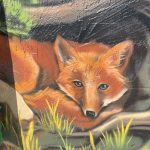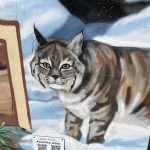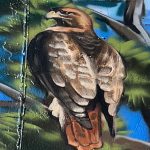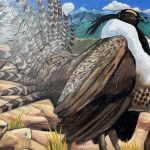Animals and Birds of Gunnison, Colorado
This guide to the animals and birds of Gunnison, Colorado features some of the local ecosystem’s most beloved species, including the endangered Gunnison sage-grouse. If you enjoyed learning about the fauna of this area, also check out the guides to plants and insects.
Mural at IOOF park
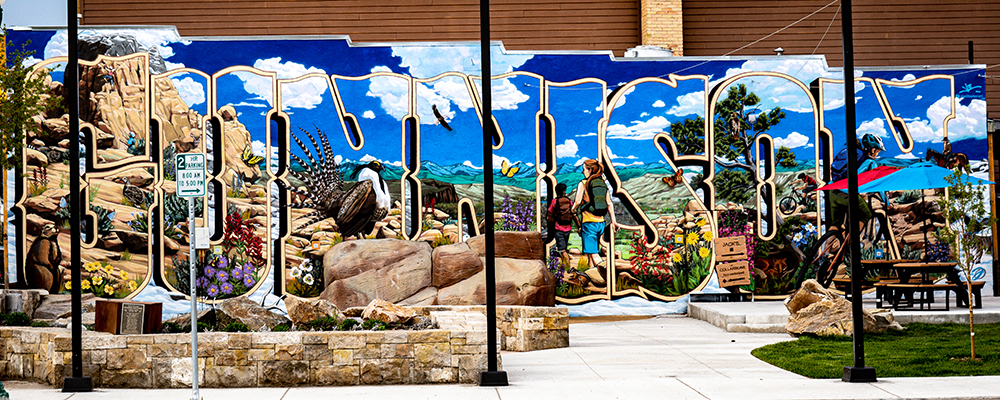
This guide was designed to accompany the mural at IOOF Park, located at 124 E. Virginia Ave. in downtown Gunnison. Each species of bird and animal featured on the mural is listed here, along with a photo of its likeness on the mural. Can you find them all?
About the author
Patrick Magee, Ph.D., is the Associate Professor of Wildlife & Conservation Biology at Western Colorado University in Gunnison. In addition to teaching courses at Western, Dr. Magee is a wildlife biologist specializing in wildlife conservation efforts across the American West.
Click or tap on the photo to learn more about that species.
Yellow-bellied Marmot
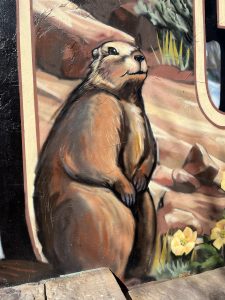
Latin name: Marmota flaviventris
Mammal Family: Sciuridae or Squirrel Family
The yellow-bellied marmot, or “whistle pig,” has chocolate brown fur with golden highlights. It sounds its alarm from a stately rock in the alpine talus field of the Rocky Mountains. The shrill call warns other marmots of an approaching threat, such as a black bear, red fox or hiker. They stand erect, watching, listening and smelling for the constant threat of predation—the number one killer of marmots. For these portly squirrels, vigilance is a requisite to survive the summers. In winter they retreat to the safety of burrows under the earth and snow. In these subterranean tunnels they drop their body temperatures, lower their metabolism and enter a state of hibernation. At ten pounds, marmots are the largest mammals that can truly hibernate. They spend much of the summer feeding on lush grasses and wildflowers in alpine meadows. They need to double their weight and deposit fat as an energy store for winter and hibernation. Unlike some mammals that make food caches in their environment, marmots store their food inside their bodies. True hibernation requires mammals to drop their body temperature to near freezing. In spring, marmots emerge from their underground dens, sometimes finding nothing but snow. Their extra fat stores at this time provide essential calories as they wait for the snow to melt and the grass and wildflowers to grow. Marmots possess two large incisors that allow them to clip vegetation. Sharp premolars and molars grind vegetation before sending it to their stomach, intestines, and cecum (a fermentation chamber filled with microorganisms that help digest their plant diet). At the Rocky Mountain Biological Laboratory in Gothic, Colorado, researchers have been studying marmots continuously since the early 1960s. Research focuses on their antipredator strategies and the impact of climate change on their survival.
(Sources: Rocky Mountain Biological Lab and https://sites.lifesci.ucla.edu/eeb-rmbl-marmots/a- marmots-life/)
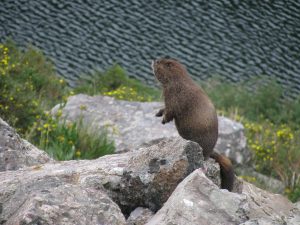
Yellow-bellied marmot. Photo by Pat Magee.
Mule Deer
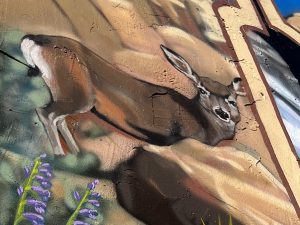
Latin name: Odocoileus hemionus
Mammal Family: Cervidae or Deer Family
Antlered bucks and antlerless does and fawns, all boasting enormous ears, roam the Gunnison Basin from low-lying sagebrush to lofty mountain peaks. These deer make annual migrations from high elevation breeding grounds to the sagebrush, where they spend the winter. The snow depth in the sagebrush is less compared to the feet of snow that accumulate in the high mountains. Mule deer have short legs, which hampers their movements in the snow and costs energy. In the winter they seek south-facing slopes with reduced snow depth so they can move around easily and access food. Mule deer primarily eat shrubs, especially in winter, meaning they eat wood. They favor mountain mahogany, antelope bitterbrush, serviceberry and sagebrush. A diet of wood inhibits digestion. Mule deer have a four chambered stomach to mechanically, biologically and chemically break the food down. The largest chamber, the rumen, harbors billions of microorganisms that biologically decompose the food in the deer’s gut.
Scarce winter food supplies require mule deer to stock up on calories in late summer and fall, reaching their peak body weight before Gunnison’s epic winters arrive. Mule deer feed on the available shrubs and rely on stored fat during winter. These calories and a highly insulative coat allow mule deer to experience below-zero temperatures without entering cold stress or needing to shiver.
However, by the end of a long winter, depleted fat stores leave the animals vulnerable to spring snowstorms and starvation. Survival rates of fawns can be less than 10% in harsh winters. Mule deer bucks breed with multiple females during the late fall rut. Most fawns are born in early summer. Disruptions to the seasonal movements of mule deer include habitat fragmentation caused by housing developments, fences, trails, roads, recreation, energy infrastructure and many other human changes to the landscape. Mule deer require migration corridors to successfully navigate to their breeding grounds and return each year. These routes resemble obstacle courses rather than functional habitats. Scientists and policy makers are recognizing the importance of migration corridors as essential elements of mule deer conservation.

Rocky Mountain Elk or Wapiti
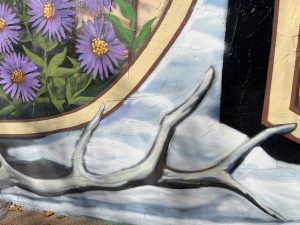
Latin name: Cervus canadensis
Mammal Family: Cervidae or Deer Family
The majestic wapiti earned its name from Native Americans referring to the large white rump of the elk. The term elk comes from “alke,” which means strength. Indeed, bull elk reach weights of 700-1,000 pounds. They are among the largest wildlife in North America, but have a stealthy ability to evade predators and remain hidden in the landscape. This has earned them the nickname “ghost of the forest.” They nearly became ghosts by the end of the 19th Century as their populations declined from 10 million in pre-settlement North America to less than 100,000 (1% of original size) in 1900. Historically, they roamed from coast to coast. Elk populations represent a wildlife conservation success story because their numbers have rebounded to over 1 million. There are 300,000 in Colorado, the highest elk population of any state. During September and October, elk enter the breeding season, or rut, and demonstrate many mysterious and astonishing behaviors. Bulls thrash trees with their antlers and scrape the velvet off, leaving them shiny. The testosterone-addled males also roll in mud and urinate on themselves to boisterously compete for the attention of the females. They begin herding females in harems of 5-15 cows, a ceaseless and exhausting task that persists day and night for many weeks. The epitome of this romance takes the form of an eerie bugle that reverberates through the fall landscape, complementing the golden transformation of aspens. The only time of year the females become receptive to breeding is during this fall window. When they are ready, they choose their breeding male. Once bred, the females become pregnant and give birth the following summer. In between breeding and birth lies winter and an upward migration to high elevation ecosystems where calving occurs.
Like mule deer, elk depend on distinct breeding and wintering grounds and the migration corridor that connects these seasonal habitats. Primarily grazers, elk consume grass as well as wildflowers, shrubs and the green photosynthetic bark of aspen. Teeth impressions in the malleable bark indicate elk activity. Elk drop their antlers in winter and spring. In recent years, Colorado Parks and Wildlife initiated a shed antler season west of Interstate 25 that closes shed hunting from January 1 to April 30 so antler collectors do not approach deer and elk and cause more stress during the most challenging time of the year. In the Gunnison Basin, antler collection is not permitted from May 1-15 before 10 am to protect the Gunnison sage-grouse.
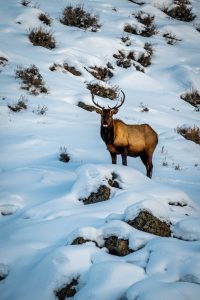
A bull elk in winter.
Ringtail
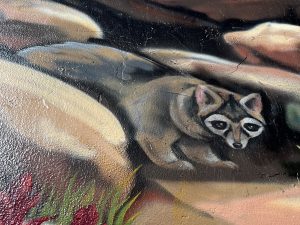
Latin name: Bassariscus astutus
Mammal Family: Procyonidae or Raccoon Family
This desert-dwelling, night-active mammal is aptly named the ringtail. Its long tail is characterized by alternating black and white bands. Its scientific name, Bassariscus astutus, means the astute or cunning little fox. However, ringtails belong to the raccoon family. They have large eyes with goggle-like white fur (reminiscent of the raccoon’s mask) that surrounds the eyes and reflects moon- and starlight from their eyes. Along with excellent night vision, they have acute hearing through their large ears and a keen sense of smell. Their two-foot long slender body, short legs, and a protracted tail make them well suited for climbing on rocks, trees and vertical walls. The tail aids in balance but does not grasp. Their hind feet rotate 180 degrees, an adaptation that improves their efficiency when descending. Ringtails have a diverse diet of fruits, insects, birds, eggs, lizards, small mammals, snakes and human food. In places such as the Black Canyon of the Gunnison National Park, campers often unknowingly fall victim to these artful thieves that cunningly raid backpacks and camp kitchens. Living in arid places, the ringtail has an efficient way to recycle water in its body so it doesn’t need to rely on external water as often. In fact, the ringtail’s kidney has the second longest Loop of Henle relative to its body size of any mammal. Another Colorado mammal has the longest Loop of Henle (guess who?).
Besides being a prominent, if not elusive, inhabitant of Gunnison River’s Black Canyon and the Gunnison Gorge, ringtails also occupy mine shafts. They have recently been discovered with game cameras in numerous mine shafts surrounding the San Luis Valley.
(Sources: Arizona Sonoran Desert Museum)
Red Fox
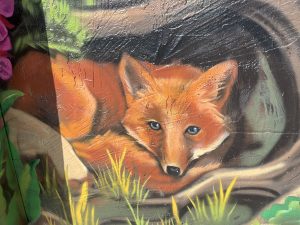
Latin name: Vulpes vulpes
Mammal Family: Canidae or Dog Family
Many associate the Red Fox with humans because they benefit from the food and cover subsidies we provide. However, they historically lived at high elevations far from human activity in the Gunnison Basin, especially in the spruce/fir forests and alpine. Most Gunnison old-timers say that Red Fox didn’t show up in Gunnison until the early 1980s. These foxes are less wilderness icon and more chicken grabbing culvert dwellers. The fox’s behavior and essence has changed, likely from genetic changes. In the early 1900s, red fox farms were popular, especially because a silver fox (a red fox with the black sheened coat) pelt would bring in $100. In the 1940s and 1950s, fox farms went out of style and many farms released their foxes into the environment. One fox farm in Gunnison was the Zugelder fox farm near Island Acres. These foxes differ genetically from wild red fox but over time the descendants of the farmed foxes have persisted and hybridized with wild foxes. This has created a new red fox that instead of fearing humans, cohabitates with us. No matter its origin, red fox live year round in the Gunnison Basin, often feeding on small rodents such as voles. In winter, red fox listen for voles under the snow and then jump in the air before plunging head first into the snow. They often pull themselves out of the snow with a vole in their jaws. Their thick coat consists of a dense layer of underfur and an outer layer of longer guard hairs. This fur allows red fox to endure temperatures of -15 degrees Fahrenheit before they begin shivering to generate heat. Red foxes defend territories and cache food for times when prey is less available. Some people suggest foxes kill for fun and do not eat their victims, but these intelligent creatures kill excess prey and store it for later use.
Least Chipmunk
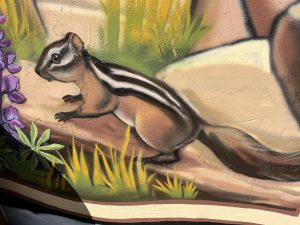
Latin name: Tamias minimus
Mammal Family: Sciuridae or Squirrel Family
The diminutive least chipmunk ranks as the smallest of all 21 species of chipmunks in North America. While it is small in size, it is the most common of the twenty other western chipmunks. Chipmunks differ from ground squirrels because they have three dark and two light stripes that extend over their face. Golden-mantled ground squirrels only have body stripes that do not extend to their faces. Least chipmunks also sport a long, bushy tail. From April to October they constantly move about their home ranges, mostly collecting food, both to fuel their high metabolic engines and to store as caches for winter. They are day active (diurnal) and therefore rely on vision and hearing to detect their food and avoid being eaten. Chipmunks eat a variety of foods, including insects and snails, nuts and fruits, and grasses and fungi—including truffles. As chipmunks gather seeds, fruits and fungi, they disperse spores and seeds, thus benefitting the species that they consume. These tiny mammals serve another important ecosystem function by sacrificing themselves as prey to many predatory mammals and birds. The main predators include weasels, mink, martens, red fox, bobcats, goshawks, Cooper’s hawks and snakes. The frenetic activity of summer slows in October, and least chipmunks retreat to underground burrows with food caches. There, they enter a light hibernation and sleep until spring. In April, they emerge from their burrows and mate. The females create an above-ground nursery nest where they give birth to the young. This nest connects to a food cache chamber of gathered and stored foods to consume and serve to their young. They have up to six jelly bean-sized young, born naked and underdeveloped. For up to 60 days the mother nourishes them with her milk. This rich milk supply allows them to grow and develop. After 28 days their eyes open, at 40 days fur fully covers their little bodies, and at 60 days they begin eating solid foods. At this time, the extensive mothering period ends, and the fully weened kits independently feed themselves and prep for winter. The young now join the adults in constant motion eating and storing food, often packing their cheek pouches with seeds that are then transferred to underground food caches. They scurry through the sagebrush ecosystem and other semi-open habitats in Gunnison’s mountains, and easily scale rocky walls and trees. All this activity, early in summer, is in anticipation of the coming winter.
(Sources: Shefferly. 2000. Tamias minimus. ADW. Animaldiversity.org; Hinterland’s Who’ Who. Canadian Wildlife Federation. Hww.ca)
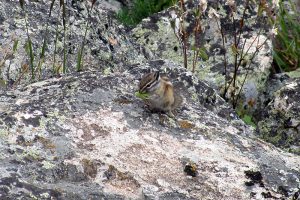
Least chipmunk. Photo by Pat Magee.
Bobcat
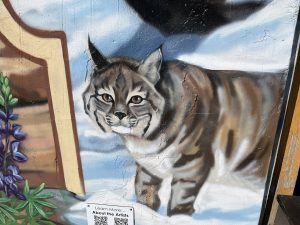
Latin name: Lynx rufus
Mammal Family: Felidae or Cat Family
Bobcats, like all members of the cat family, are highly specialized carnivores. They have sharp canine teeth for sinking a deadly bite into an unwary victim, retractile claws that grasp the victim and hold while the canines sink, and canine-like molars adapted for shredding the victim’s flesh. In addition, the bobcat has flexible joints and the ability to run fast and leap far. The cat mostly hunts by stalking, then ambushing its unsuspecting prey, which consists mostly of rabbits and rodents. They less frequently stalk and kill birds and larger mammals such as deer (usually fawns). In addition to ample vegetation cover, the cover of darkness aids bobcats in their stealthy movements as they corner their quarry. They most actively hunt at dawn and dusk, a crepuscular activity pattern. Like most predators, bobcats defend territories and ceaselessly patrol and mark the territory boundaries. Territory defense marking consists primarily of chemicals that provide an olfactory fence and include urine, feces, and scents excreted from glands on the feet and anal region. The cats need large home ranges that support an adequate food base. Males and females defend territories. Neighboring females are often sisters or cousins, as they remain geographically stationary, while juvenile males, 12-18 months old, disperse from natal territories seeking a vacant home range. While common in the Gunnison Basin, these elusive solitary carnivores with large home ranges and low population densities scarcely encounter humans.
(Sources: San Diego Zoo Wildlife Alliance Library. Ielc.libguide; Draeper et al. 2022. BMC Ecology and Evolution 22(25).)
Red-tailed Hawk

Latin name: Buteo jamaisensis
Bird Family: Accipitridae or Bird of Prey Family
The word “hawk” means to seize or take hold. That perfectly describes this avian meat eater, who uses its massive talons with decurved sharp claws to seize rodents, rabbits and other prey such as reptiles, bats and birds. Each prey type requires a unique method of hunting, making the red-tailed hawk an improvising hunter. In addition to its talons, the sharply bent raptorial bill aids in ripping flesh from its prey. Red-tailed hawks often perch on power lines or tree branches and wait for prey to appear. Their large eyes have eight times higher resolution than humans, and they have five times more photoreceptors in their hawkish eyes compared to human eyes. At other times they soar over open lands searching for prey and may swoop at speeds up to 120 mph to chase a running rabbit. Red-tailed hawks are classified in the Genus Buteo, which refers to a buzzard. A buzzard has a blocky body shape, a broad fanned tail, and large, rounded, soaring wings. The cinnamon tail on red-tailed hawks contrasts with its brownish body and a dark belly band. Red-tailed hawks come in a wide variety of colors and plumage patterns, some even lacking the distinct red tail, which is an adult characteristic. Their large slotted wings allow them to take advantage of thermals and soar effortlessly on ascending air currents. However, they rely on these thermals and often remain grounded until the air warms and thermals begin to rise. Red-tails typically mate for life, each season building a massive stick nest or refurbishing their previous nest on a cliff face, in a tree or even on buildings or transmission towers. The female incubates two eggs while the male hunts and brings food to the female. Upon hatching, the male and female take turns brooding and provisioning the chicks for six weeks. Even though the chicks take their first flight at 45 days, they remain reliant on the adults for a couple months, at which time the red-tail juveniles become independent and may disperse long-distances from the parents’ territory. Meanwhile, the parents continue to patrol and defend their territories, that may be up to two square miles in size, year-round. Some red-tails migrate before winter, but many reside in the same location, sometimes within the same territory, all year and for more than a decade. These aerial monarchs soar against Gunnison’s blue sky, calling out with their famous raspy screech. As winter yields to spring, the paired adults fly upward, lock talons with their mate, and spiral downward, signaling their commitment to another season of raising the next generation of red-tailed hawks.
(Sources: nhpbs.org/NatureWorks; Allaboutbirds.org, Cornell Lab of Ornithology; ABCbirds.org)
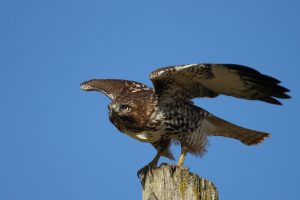
Red-tailed hawk. Photo by Dan Piquette.
Bald Eagle
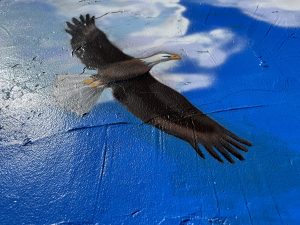
Latin name: Haliaeetus luecocephalus
Bird Family: Accipitridae or Bird of Prey Family
The scientific name of the bald eagle translates to the white-headed sea eagle, a “majestic” bird deeply revered as the national symbol of the United States since 1782. While the bald eagle often soars on broad slotted wings and hunts for ducks, grouse and mammals, it also often feeds on dead carcasses, like a vulture sticking its stately head into a gory road-killed deer. They also steal food from other predators, an act called piracy. This piracy and carcass-eating behavior concerned Ben Franklin, who questioned whether the bald eagle had the right moral character to serve as our nation’s symbol. The white feathered head and tail contrast with the dark chocolate body. Males and females are indistinguishable, but white-headed adults look different than juveniles, who require five years before attaining full maturity including their regal colors. For their first four years, juveniles travel far and wide, up to one hundred miles a day, in search of a territory. Eventually, they mate and nest in their fifth year. Bald eagles often gather in large flocks in winter and may also nest in dense concentrations. Their populations rebounded after the U.S. banned DDT, a dangerous pesticide, in 1972. Prior to the passing of this law and the 1973 Endangered Species Act, bald eagle populations plummeted for many decades and reached a low number of about 417 nesting pairs in 1963. Forty-four years later, in 2007, the U.S. Fish and Wildlife Service declared bald eagles recovered under the Endangered Species Act and removed the them from the list of protected species. In the last 10 years, its population size has quadrupled to over 71,000 nesting pairs with 316,700 individual bald eagles living in contiguous United States. Many more live in Canada and Alaska.
(Sources: Allaboutbirds.org, Cornell Lab of Ornithology)
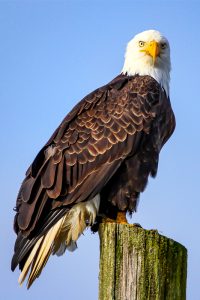
Bald eagle. Photo by Dan Piquette.
Gunnison Sage-grouse
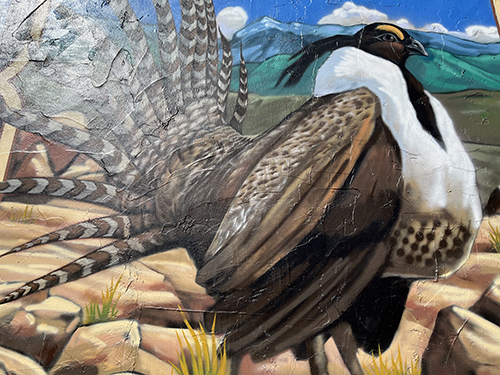

Latin name: Centrocercus minimus
Bird Family: Phasianidae or Pheasant and Grouse Family
The Gunnison sage-grouse inhabits the Sea of Sage, where its life intertwines with this fragrant evergreen shrubland for all of its life cycle needs. Designated as a distinct species of bird in 2000 and found nowhere else in the world, the endemic Gunnison sage-grouse occurs in southwest Colorado and southeast Utah, with 87% of the global population in the Gunnison Basin. The species’ unique mating ritual transpires with extraordinary fidelity each spring in specific time-honored locations, called leks. In the predawn darkness, surrounded by moonlit frosty sagebrush, males lift their wings and take two steps forward while they fan their banded tails. Then males thrust their heads forward, flinging lavish pony tails. They simultaneously inflate two yellow air sacs that protrude from their chest. They emit a low frequency liquid plopping vocalization that resonates far into the sagebrush sea. This acoustic beacon attracts females to the dance lek, where the ladies meticulously observe and rank the males’ performances. Eventually, females choose a male and they mate. Curiously, most of the females choose the same male, who, on large leks, may mate with up to 20 or more females in one morning. The fierce competition among males allots the duty of siring and passing genes to the next generation to only a few males (about 10%), the rejected males destined for oblivion. After mating, the females and males do not form any sort of bond. The rest of the job of reproduction solely lands among the duties of the hens. They wander through the sagebrush and choose a nest site under thick sagebrush with dense grass to conceal their ground nests from predators. They lay between six and eight eggs and incubate them for about 28 days. Incredibly faithful throughout this period, they only leave the nest in two short feeding bouts each day. Immediately upon hatching, the chicks follow their mom away from the nest. They seek wet meadows where plentiful insects provide a high-protein diet that fuels their rapid growth and feather development. By the end of the summer, broods of chicks and their hens coalesce into larger flocks and begin moving toward long-established wintering grounds. There, they survive the brutal cold and snowy winters by burrowing beneath the snowpack. The winter diet of the Gunnison sage-grouse consists almost completely of sagebrush leaves. No other species’ existence so utterly hinges on the presence and health of the sagebrush ecosystem. Less than 4,000 Gunnison sage-grouse persist on the planet. Their providence depends on local conservation, including restoration of wet meadows, control of invasive cheatgrass, management of outdoor recreation and livestock grazing, and enforcement of policies that restrict developments that further fragment the sagebrush sea, making it less hospitable to the sage-grouse. When taxonomists officially bestowed a name on the Gunnison sage-grouse, they both honored the Gunnison community with their selection and invited Gunnison residents to embrace the challenge of conserving an imperiled species that has endured for hundreds of thousands of years in the face of exploitation, the loss of 90% of habitat, and constant human pressures moving them deeper into the sagebrush sea.
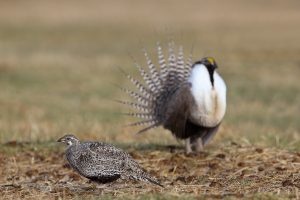
Female (front) and male Gunnison sage-grouse. Photo by Gary Kramer.

Male Gunnison sage-grouse. Photo by Gary Kramer.
Where to find these animals and birds
The best way to view wildlife is on a quiet hike through the backcountry around Gunnison. The best time to do it is at dawn or dusk, since that’s when most animals and birds are most active. It’s also possible to view wildlife from your car. Always give birds and animals a wide berth so you don’t disturb them. It’s recommended to keep a distance of at least 25 yards from most wildlife, and 25-100 yards away from big game (like moose) and predators (like bears).
Seasonal trail closures for wildlife
Several areas around Gunnison are closed to visitation in spring to help with wildlife (including animals and birds) conservation. This includes trail and road closures for elk on the south side of Hartman Rocks and for the Gunnison sage-grouse at Signal Peak.




